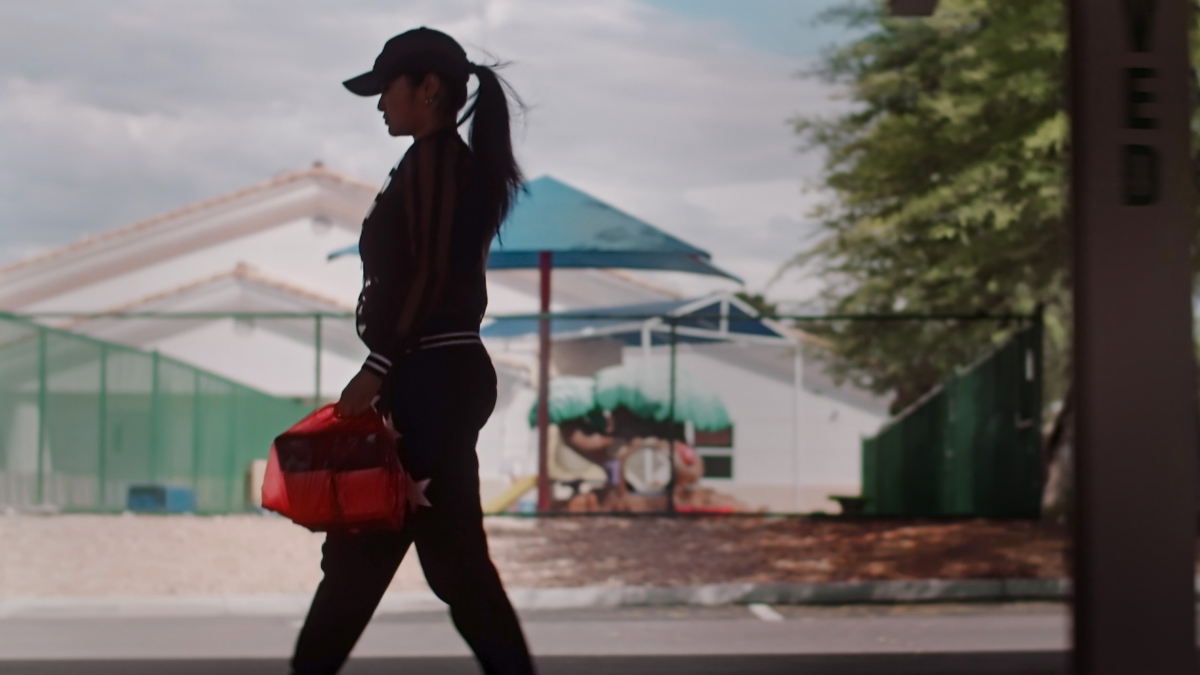Written By: Saiya Floyd
The first glimpse we get of Tera — the protagonist of “Take Out Girl” — is of the back of her head. More specifically, the baseball cap that says “Never Compromise.” And neither Tera or the movie does.
When we meet Tera, she drops out of school in order to help her mother at the family’s Chinese restaurant. It’s not that school is too hard — she runs a popular side hustle of selling fellow students her notes and test answers — it’s that Tera thinks the best way to help her mom is by being there. It’s this desire to help her family achieve a better life that propels the film. Tera soon moves onto a new side hustle: she transports packages for drug dealer Lalo. It’s Tera’s idea. She suggests using food containers as a cover, reasoning that most people wouldn’t look twice at an Asian woman delivering Chinese food. Lalo agrees to her idea, and suddenly Tera finds herself in a new world of danger.
The script was co-written by Hedy Wong, who plays Tera, and director Hisonni Johnson. The idea was originally Wong’s. “I got to a point in my life where I was doing a lot of self reflection on the past and present and how my upbringing shaped the actions I’m taking in the present. ‘Take Out Girl’ was an outlet for me to get certain things off my chest about family and environment.” She approached Johnson with a first draft, and he was intrigued. They workshopped the idea, figuring out how to streamline the story. They decided to make Wong’s character more prominent. “Hedy’s personality is undeniably unique and incredibly intriguing. I knew from the moment we first spoke that she had qualities that could engage viewers,” Johnson said. “Yes, she’s a wonderful actress and her walk, voice, and overall swagger … You’re just born with something like that. It’s one of a kind.” Once they realized that Tera was the film’s spine, they began writing the screenplay, collaborating over the phone as Wong is based in LA, and Johnson in Las Vegas.
Wong makes an intriguing leading lady. Her Tera is guarded and tough — for the most part. Wong and the screenplay allow Tera just enough moments where she can relax and enjoy time with her family for us to remember that at the end of the day, Tera is a girl who wants to help her family, but has few paths to do so. But even in these softer moments, Wong never completely loses her edge. The performance is even more impressive considering the aforementioned hat that Hedy keeps on for the bulk of the film. But instead of being daunted by playing a character keen on hiding her face, Wong relished the challenge. “I was lowkey excited that Hisonni let me wear a hat for the majority of the movie. Because that’s how I really was at one point in my life. Society places so much attention and value on the looks of a woman. I wanted to be judged for what I’m saying and doing, not on how I look. I know Hisonni sees the hat as Tera’s superhero cape.”
Tera needs her cape as she adjusts to the new world she’s a part of. Ski Carr is genial as crime boss Lalo, but gives just enough menace to make it clear that Lalo is not someone Tera should cross. J. Teddy Garces is a much more active threat to Tera as Hector, Lalo’s right hand man. On top of her new role in the drug ring, Tera has her mother’s health to think about, and a volatile brother to worry about.

The Wong family dynamics help root the story, especially Tera’s relationship with her mother. Both women want to protect each other from harsh truths, but this requires hiding problems from each other. You wonder how different their lives would be if they were more honest with each other, but their stubbornness in taking on a bigger burden to shield the other feels very real. “I noticed the often missed opportunities between people for a better human connection — we get so caught up in our various pursuits,” Wong said. “Just like how Tera is caught up. While money makes the world go round, I think it is really the quality of our relationships with those around us that determines the quality of our lives.”
Family is a big part of the story. So is the environment. To Johnson, the environment was the real antagonist. “To me, there are only three types of stories told. Man VS Man. Man VS Environment and Man VS Himself. I realized that Tera, our main character’s battle, was against her environment. Specifically, her impoverished environment. So, I treated the environment as a character and developed it by showing the hood’s unforgiving nature.”
“Take Out Girl” has a strong sense of place that makes Tera’s struggle that much more palpable. Johnson achieved this with strong visual choices and a great soundtrack. “As a black man who was making a film set in the hood, my instinct was to grab the hottest hip hop artists I knew and be done with it. It wasn’t until I was a third of the [way] through post-production that I realized that this could be my only chance to put Asian American hip hop and pop artists on a platform.” He and his team ended up getting rights to music from Tim, a New York based rapper, and $tupid Young, a rapper based out of Long Beach.
This hands on approach was something that was important to Johnson. “I’m a puzzle nerd. Editing, directing, producing, etc, they’re just puzzles I can let get the best of me, and the high I get from being in that ‘flow state’ feels the same regardless of the task. I’m always chasing that high.” On “Take Out Girl”, Johnson worked on the screenplay, shooting, editing, location scouting and more. “I wanted to be a craftsman, and Hedy needed a craftsman to make this film come to life … On ‘Take Out Girl’, my fingerprints are everywhere.” The drive to do whatever it takes to see a creative vision through was something that resonated with Wong. She saw in Johnson someone with the same grit and desire to complete the project without compromising their vision. “Teamwork can be hard work at times but it’s the only way to make the bigger dream work. The journey was a hard one but we believed in what we were trying to accomplish together. ‘Take Out Girl’ is for sure the definition of a passion project.”
It was a project Wong wanted to take on after getting tired of waiting for the phone to ring. “A painter doesn’t wait to be commissioned before painting something. A recording artist doesn’t wait for a major label to sign them before making music. Invest in yourself first because nobody else will.”
The decision to take one’s destiny into one’s own hands is something Wong and Tera share. Though the path Tera chooses to take is specific to her situation, her desire for a better life for herself and her family is universal. “My top goal was to make my Asian American protagonist universally relatable,” Johnson said. “And I think we accomplished that.” To Wong, the film meant a lot of things, but it was also about making people feel seen. “Over the years, some of the themes of the story have changed for me. When I first started writing the script, I wanted to let others know that they weren’t alone in their struggle and self-doubt and that not all money is good money.”
All money might not be good money, but there is value in knowing one’s worth. To Johnson, this is what the film is all about at its core. “‘Take Out Girl’ is the story of a woman who, in her heart, knows that she’s better than her circumstances dealt upon her, and it’s this belief that propels Tera toward her upgrade from economy to first-class.”
“Take Out Girl” makes its East Coast Premiere at the 43rd Asian American International Film Festival. Ticket and screening information can be found here.

